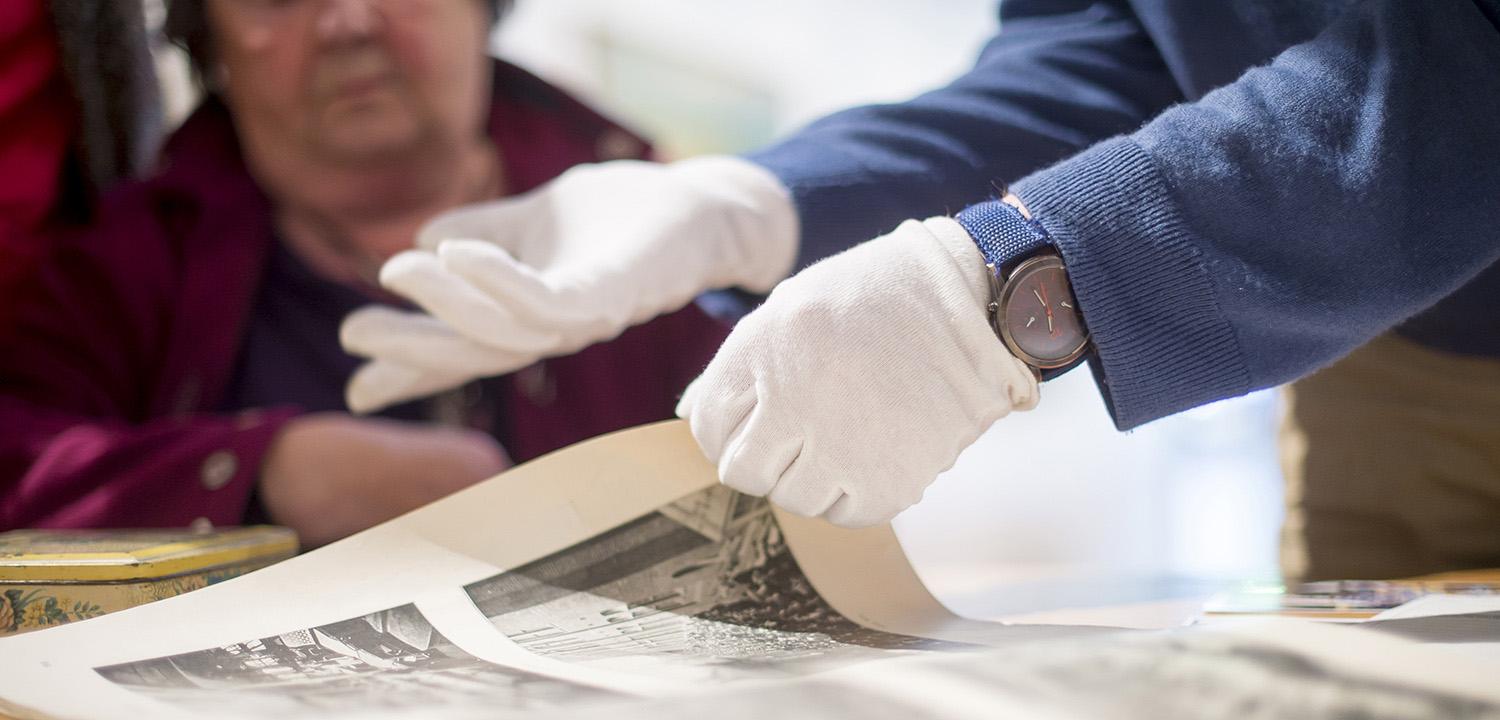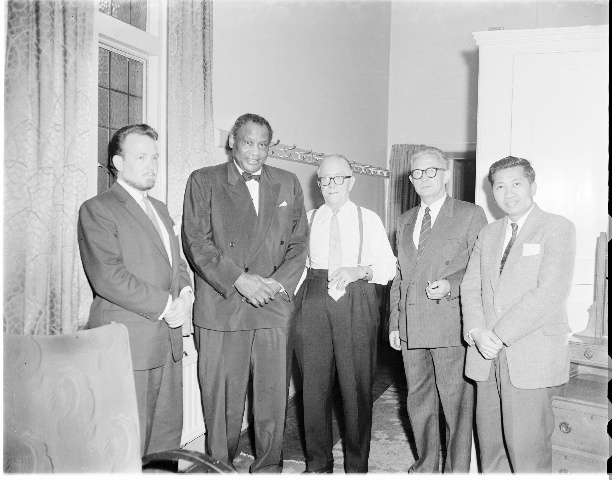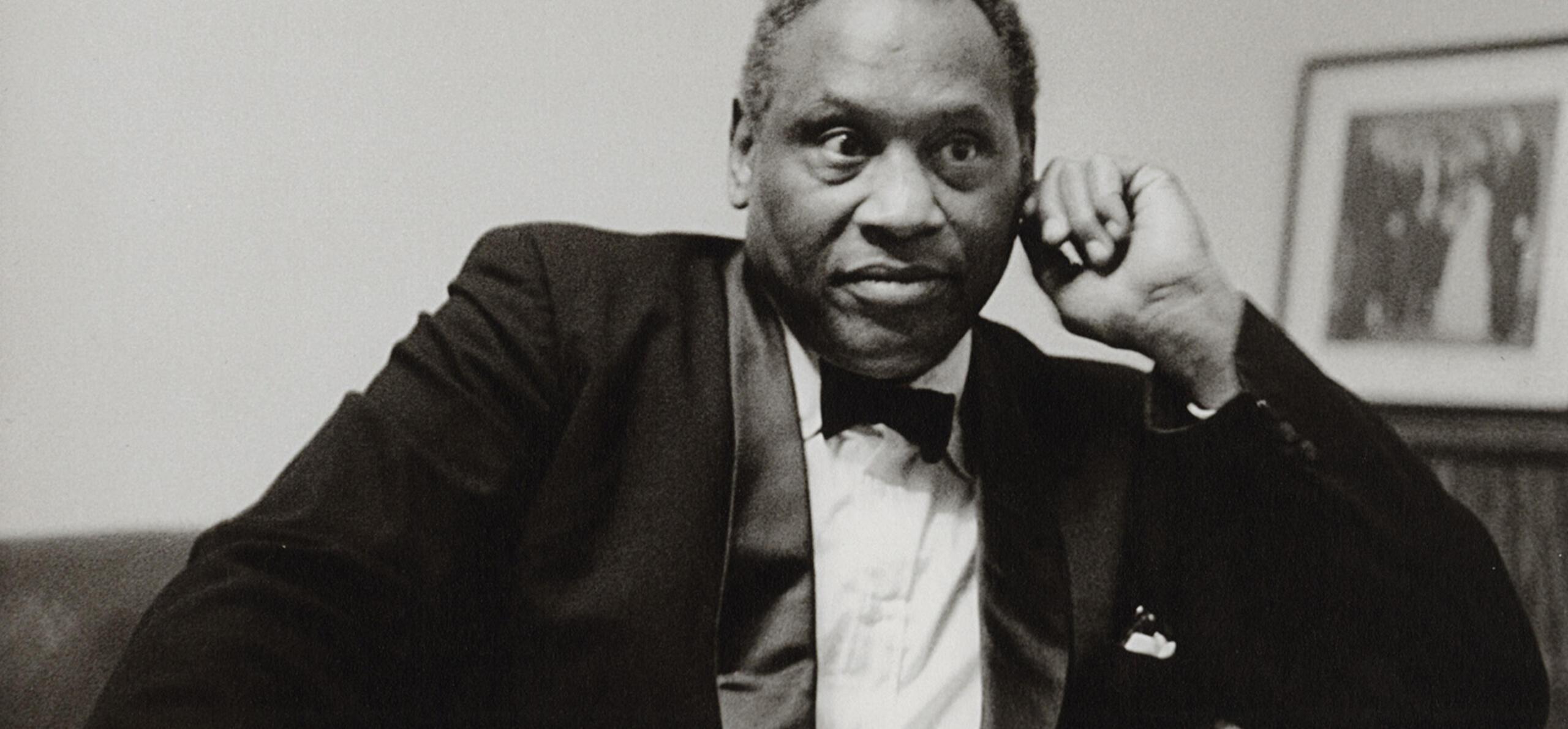(Header image credit: Paul Robeson by Neil Libbert 1958, NPG x136292)
Behind the scenes of all museums, you will find collection assistants and volunteers working hard to improve the Museum’s knowledge of what is held within its collections.
Through this important but perhaps unsung work, it’s possible for hidden stories and long-lost stories to be rediscovered.
This is exactly what happened in January 2012 when we discovered Reading's link to virtuoso black American artist Paul Robeson.

Great care needs to be taken when handling archival material, just like here!
Reading and Paul Robeson
At the time, research was being undertaken at Reading Museum into our vast collection of glass-plate photographic negatives. These were donated to the Museum in 1980 by the Berkshire Chronicle (now Reading Chronicle) and consisted of over 100,000 photographic negatives recording moments and scenes from Reading’s modern history.
One of the Museum’s volunteers, Amanda, embarked on the Herculean task of creating a database of these photographs, forming a searchable index through this quite astonishing collection, and listing them with descriptions so that this fantastic history could be easily navigated in the future.
In 2012, we were conducting research into life in Reading during the 1960s, when we discovered quite an awe-inspiring photograph, showing none other than Paul Robeson, one of the fathers of the American Civil Rights movement, performing at Reading Concert Hall.

Paul Robeson photographed after performing at Reading Town Hall, 1960 (REDMG : 1980.36.D167.4)
Who was Paul Robeson?
Students of black history will be familiar with the life and works of Paul Robeson (1898-1976), a brilliant and hugely multi-talented 20th century American singer, actor, artist, and political activist.
Robeson was born in the closing moments of the 19th century, in Princeton, New Jersey, to Anna Louisa and William Drew Robeson. His father was a clergyman, but previously had been enslaved. His mother died in a fire when Paul was just six years old. The family would then move to Somerville, NJ, where Paul demonstrated exceptional aptitude in school and a beautiful singing voice at church.
At the age of seventeen, Paul began a fantastic academic career. He earned a scholarship to Rutgers University, where he received huge acclaim for his oratory talent, debating skills, and ability as a sportsman. He then continued his studies at Columbia University’s Law School.
As Robeson began his legal career after graduation, he encountered extreme resistance. The American legal world was beset with racism and prejudice, and opportunities for people of colour were limited.
With the support of his partner Eslanda Goode (a student and journalist whom he met at Columbia), Robeson moved from the law to the arts. With Eslanda as his manager, he became a prolific actor, singer and performer, dazzling the West End, Broadway, and Hollywood with an enormous range of high-profile performances and his fantastic voice.
As well as his fantastic artistry, Robeson was a tireless political activist and campaigner for social and racial justice. He was a passionate supporter of Pan-Africanism, a union organiser during the Great Depression, performed for Loyalist soldiers during Spain’s Civil War, and participated in anti-Nazi demonstrations throughout the Second World War. A remarkable video from the BFI archive (below) captures Robeson singing to Scottish miners at Woolmet Colliery (near Edinburgh) the song ‘I Dreamed I Saw Joe Hill Last Night’, telling the story of a labour organiser who was executed after being framed for a murder charge.
During the rise of McCarthyism and the enormous distrust of political activism in 1950s America, Robeson found himself decried by government officials (and some Civil Rights leaders) as being anti-American, a communist, and supporter of the USSR. These allegations led to his blacklisting, and a period of political exile ensued in which Robeson’s passport was not renewed by the American State Office.
Robeson in Reading
It was during this period of political exile that Robeson arrived in Reading.
Robeson was widely loved in Europe, and in the early 1960s, he toured the concert halls of Great Britain. This included an appearance at Reading Town Hall, where Reading Museum is today.
Robeson was the final act in a fantastic evening line-up at the Concert Hall, arranged by Reading and District Association for Peace, following other performers such as Reading’s newly formed youth choir, The Clarion Singers, the Canadian pianist Neil van Allen, and more.
Now, returning to 2012: the glass-plate negative that our volunteer Amanda found was digitised, and revealed the photograph featured earlier in this article. It portrays Robeson as an older man, donning a sharp tuxedo, a bowtie and a smile, just after finishing a performance that was met with rapturous applause.
The Coming Home Project
In 2019, the National Portrait Gallery launched a project called Coming Home. This involves iconic portraits of sitters being returned to places with which they bear a historical significance.
After discussion with representatives of Reading’s African & Caribbean Community and the National Portrait Gallery, it was agreed that the story of Robeson in Reading presented a fantastic opportunity for the portrait to be loaned to Reading Museum.
It was an iconic movement in the cultural life of the town in the 1960s, highlighting the impact that Robeson, an extraordinarily significant and gifted figure, brought to Reading in the early 1960s through the form of his message, at a time when the town was becoming home to new communities of people of colour from all across the world.
With enormous thanks to the National Portrait Gallery, the portrait of Paul Robeson will be on display at Reading Museum from the 20th October as part of the Coming Home project. Book your free visit online and discover this wonderful portrait in person.
Watch the unveiling of the portrait in the video below:
A Tribute to Paul Robeson
In December 2020 Reading Community Gospel Choir, actor Steve McCauley and Reading Museum recorded a tribute to the iconic artist, activist and performer Paul Robeson.
Recorded at Reading Town Hall, where Robeson himself stunned an audience in 1960, at concert arranged by Reading Foundation for Peace, this performance formed part of the National Portrait Gallery’s Coming Home project, and coincided with the loan of a portrait of Robeson to Reading Museum.





